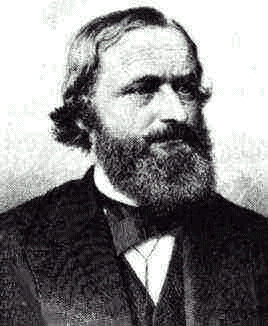Gustav Kirchhoff
Gustav Kirchoff (12 March 1824 – 17 October 1887) was born in Germany in the early 1800s to British gypsies. Even though he was born a German, his nationality was Prussian, but his heart was in Canada. This is because Germany auctioned him off as a small child to raise the money needed for the unification (c. 1870). Prussia won him with a bid of a small pebble, which is approximately £15,000 in modern money.
In 1845, Kirchoff passed his circuit laws while he was still in university. Therefore, we must thank the German legislation that forbids students to stay at any university without being permanently drunk, for without this law one wonders whether young Gustav would have ever thought up the idea of studying currants.
If you would like to recreate the historic moment at which Kirchoff stumbled upon these laws, then drink large amounts of German lager, then drop a berry into a tube. Make your observations, construct a table (Kirchoff's had six legs), draw a graph and corresponding log graph then publish your results and drink some lager to celebrate.
In 1861, he "discovered" caesium and rubidium with Robert Bunsen. In reality, these metals were just bits of Bunsen's bed springs coated with paint bought from their local Homebase.
In 1887, Kirchoff passed away quietly while choking on a piece of caesium, which he mistook for a slice of Bratwurst. This tragic event has stood firmly in people's minds and, even today, students are told never to eat in a laboratory.
Kirchoff's Circuit Laws[edit | edit source]
Kirchoff did many things for physics that we shall be thankful for (two) generations to come, but without doubt his most important works come in the form of his circuit laws.
Law One[edit | edit source]
The First Law states that the sum of the currents flowing into any point in the circuit is equal to the sum of the currents flowing out of that point.
This may seem confusing to those that are not in the slightest way connected with electricity, but actually it is very simple. Basically, he is saying that if you put a currant into a tube, you get a currant out again.
Just as a passing note, some more recent physicists suggest that this law can be extended to refer to any pieces of fruit and not just the humble currant. This theory is currently being examined fully by Kirchoff's most diehard supporters, but results are not expected for the next few decades, because, sadly, Kirchoff has no diehard supporters.
Why Law One is any use to anyone at all[edit | edit source]
Law One, although it may seem simple and boring, is actually one of the most fundamental laws in all of physics. As suggested above, try recreating the experiment and follow the on-screen instructions.
- Put a red currant into a tube.
- Watch the red currant fall out of the bottom of the tube.
Did you notice? The currant fell out of the bottom. Imagine what would have happened if, for example, TWO currants had fallen. You would have made a currant. The government would then have stolen your tube and used it to stop people in the third world dying from hunger. But then, because they only live off red currants, they would get some terrible contagious disease (contracted by eating too many red currants). The disease would spread around the world and the human race would die out.
So remember Kirchoff whenever you put a berry in a tube. His laws are there, keeping you safe!
Law 2[edit | edit source]
Kirchoff stated that the sum of the e.m.f.s around any loop of a circuit is equal to the sum of the p.d.s in that loop.
In reality, this isn't actually a law. The reason for this is that e.m.f.s and p.d.s are not fruit related and, as anyone who knows anything about physics will know, theories or laws that are not based on a suitably nutritious substance are deemed to be nonsense (quantum is a type of apple).
Kirchoff, drunk with fame and the promise of power a second law would give him, just made it up to satisfy the punters.
This is very similar to Einstein's equation . Many believe that this is an equation for the energy of matter. The aforementioned many are actually totally wrong.
In reality, Einstein was just an attention seeker and formulated this equation because he wanted to get laid. He had read Kirchoff's work and decided to expand on it. "c" does not stand for the speed of light, "c" stands for the speed of currants. "m" stands for mass (specifically of one currant) and "E" stands for m multiplied by c2. If we look closely at this, we realise that the equation means nothing.
As a side note, it didn't get Einstein laid.
Law 3[edit | edit source]
Law three was devised by Kirchoff on his deathbed and, again, protects our society from the evils of red currant related disease.
He says that the sum of the currants in two bags is equal to the sum of the currants in one bag, plus the sum of the currants in the other bag.
This law is not very widely known, probably for the simple reason that he never told anyone about it until the most stupid of people re-discovered it and told the world. Another reason that it is not widely known is that it doesn't exist, bless it.
Although some may think that non-existence is a serious let-down for a theory, in actual fact it can often be a useful property. In modern-day physics, things are not bound by the laws of "existence", "empirical evidence", "observable reality" and such nonsense. Things need not be real for them to be real. Also, when things are not real, you need not pay tax on them.
Kirchoff's Law of Thermal Radiation[edit | edit source]
Kirchoff, although obsessed by currants in his earlier years, started to grow less fond of them and gave them up for the more lucrative prospect of thermal radiation, hoping that it would gain him the gratitude that he so longed for.
He didn't gain the gratitude because the best law that he could come up with was at thermal equilibrium, the emissivity of a body (or surface) equals its absorptivity. What he meant by this was that if you kept a fat person at a constant temperature (namely 750 degrees Celsius) they would not get any fatter. This is because they would be turned to ash, although this was not known in Kirchoff's day. Indeed, just a few hundred years before him, people believed that the sun was a great place to go on your holiday. Everyone assumed that no-one came back because it was so great. When Galileo spoke out and told everyone the truth, the Church got very upset and promptly banned him from heaven.
Kirchoff discovered this after an accident with his lab assistant, a dishwasher, an irate mouse, a CD whom he addressed as Boris (there is no line between genius and madness in physics) and one of Bunsen's bigger gas burners. The mouse never made it, but the assistant got a great new nickname and roasted mouse for his tea.
Kirchoff noticed that while the mouse was being fried, it did not get any fatter, hence his equilibrium law.
In Summary[edit | edit source]
Kirchoff was a great man and has done wonderful things for lovers of currants everywhere. He has saved the world from desecration by currants and has helped young children get exactly what they want for Christmas every year. So next time you play a game involving currants and tubes, take a few seconds to remember that without Kirchoff, you may not be able to.



